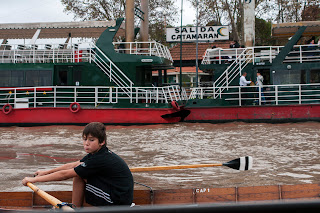Tigre is one of the largest river deltas in the world and in my experience, functions much like a major roadway. Ferry's bring inhabitants and visitors up and down the river and it is common to see crew rowers fine-tuning their strokes. A boy paddles his boat past our docked ferry and as his vessel, which seems much too large for a single rower, cuts through the cloudy - clay-colored - water. His was the first of many types of boats found on El Tigre.

As we venture away from the dock and into the forrest-lined river, we pass a riverboat that has long since run aground. The rust covering the tin-roofed cargo boat is a clear indication of the history of this river. The aged buildings, peppered into the scenic landscape, all seemed as if they could tell a story. The river had been running long before people went there and will be running long after they're going. As the paint of the houses peal and the boats drift ashore, all human interaction with the waterway eventually becomes part of Tigre's history.
Our destination is a stilted house, the vacation home of our gracious host of the day. Horacio de las Carreras, a lawyer by day and a writer by night, was a most inviting and generous host who invited us to his home on Tigre, cooked a first-class meal and shared his Mate with us. A true "Gaucho Intelectual," as quoted by his daughter, Emilia who has been our local contact on this trip.
Just as the semi-tropical forest engulfs the remains of the man-made along the river, the lived-in home of Horacio also seems to be surrounded by plant life. Argentina demonstrates and interesting relationship between nature and the made made. The tropical bushes seems to almost be imbedded into the house, which is situated a short two to three hundred meters from the riverbank.


Less than a stones-throw from the front door of the house is the charming yellow motorboat corralled at the dock, much like a car parked in a the driveway. The water is the primary mode of transportation for the people who live on Tigre. As one could imagine, flooding is common and the dense forest of trees makes roadways nearly impossible. Horacio's house used to be a plantation that produced trees, which were ferried upstream and used for building and burning. The path through the plantation, like every other structure on Tigre is built up so allow for the owner to check the plantation even during a rainy spell. The river permeates the community of Tigre and is such an uncontainable force that it is one of the few places where man-made structures work around the presence of nature. This also speaks to the natural / human-produced relationship we observe in so many areas of Argentina.







Only you could capture such a priceless face on the small boy in the first shot! I've spent about six minutes trying to pick the ripe words to describe his expression. Here is the dialogue that preceded it:
ReplyDeleteRowboat navigation: "There are 4.3 miles left until you reach your destination."
Him: *with sad, downcast eyes* "Whatchu talkin' bout Willis?"